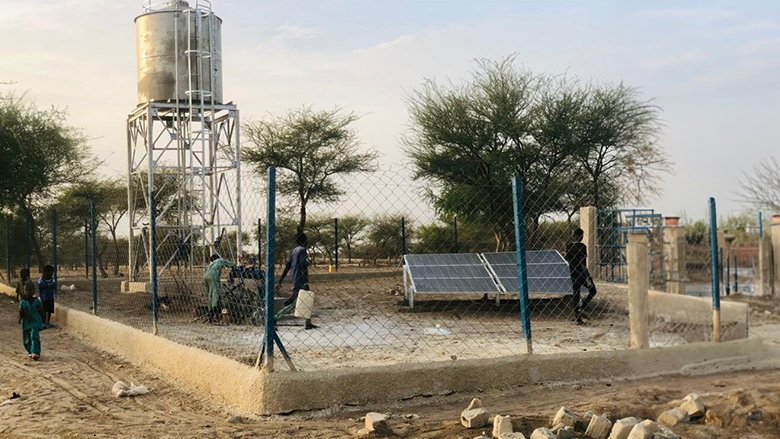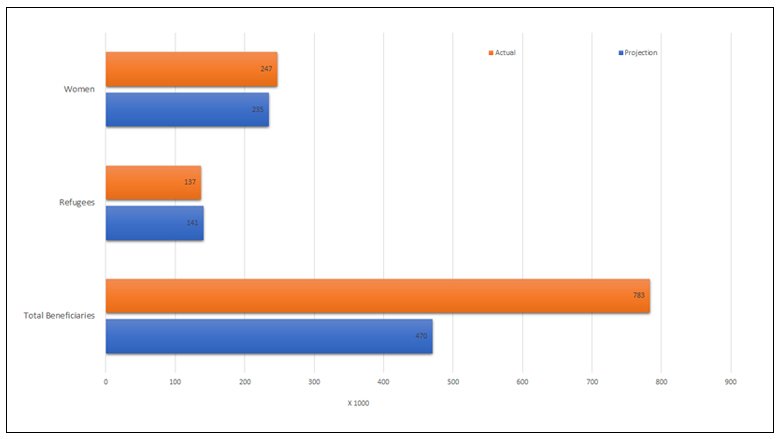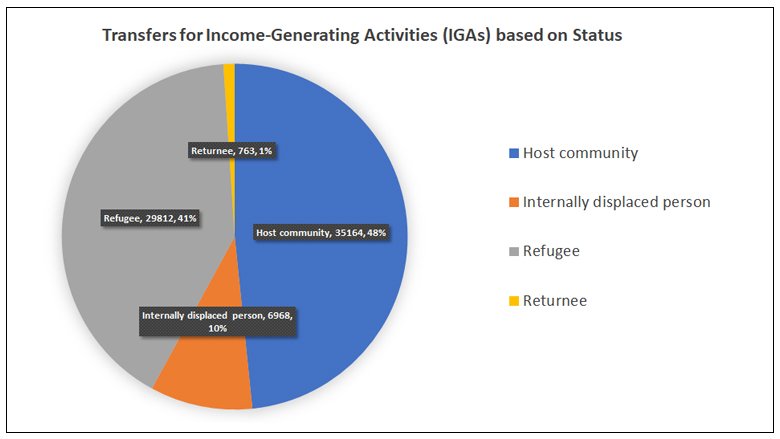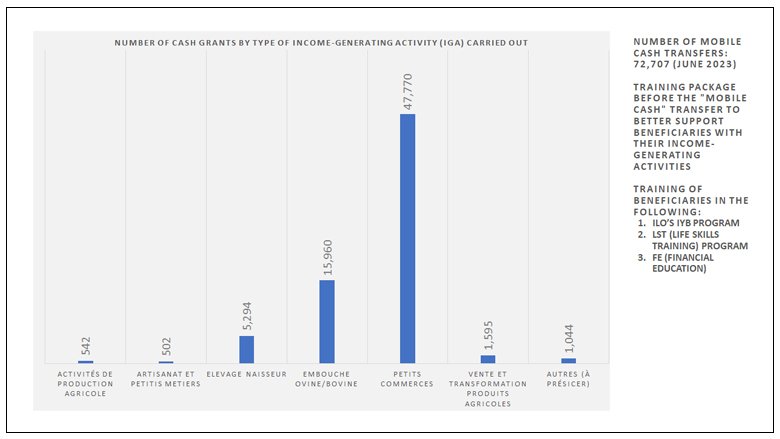Challenge
The core development challenge was to ensure that refugees, internally displaced persons, as well as host communities—often located in fragile geographic areas—had access to improved basic services and economic opportunities. This effort faced a number of challenges in the complex context of Niger. According to UNHCR, escalating conflicts and deteriorating security situations increased the forcibly displaced population in the Sahel to 4.1 million people in 2022—up from 3.6 million at the end of 2021. This included 1.1 million refugees and asylum-seekers and 3 million IDPs. In Niger, the number of refugees, IDPs, and returnees has increased from 280,000 people in September 2018 to 705,968 in September 2023. Forced displacement also expanded geographically, affecting more Nigerien regions, such as the southern Maradi and Tahoua regions. Compounding the challenge of increased numbers of refugees and IDPs, these populations are not easy to reach, as they tend to move frequently due to changing security situations. As many refugees and IDPs live together with host communities, socioeconomic tensions may arise due to a lack of resources, services, and jobs. Finally, refugees, IDPs, and hosts in fragile areas need support tailored to a FCV environment.
Approach
Between 2018, when PARCA was launched, and 2023, when it closed, it sought to improve access to basic services and economic opportunities for refugees, IDPs, and host communities in a complex operational context. One component focused on rehabilitation or newly constructed community infrastructure to provide improved access to basic public services, such as education, health, water, and economic infrastructure, while another component supported economic opportunities through training and mobile cash transfers.
To meet these aims, PARCA was designed to take fragility, security dynamics, and frequently-moving beneficiaries as a given—not as a surprise. PARCA used the World Bank’s Geo-Enabled Monitoring and Evaluation System (GEMS) as a monitoring tool, as well as a proactive design and implementation tool. For example, GEMS enabled the identification of location, sector, and size of PARCA’s infrastructure investments and income-generating activities (IGAs), thus responding to local needs, and helping to safeguard the project against the possibility of influential stakeholders directing investments to meet their subjective interests. This also provided legitimacy to locally elected officials (such as mayors), with whom PARCA closely collaborated during project identification, specifically by justifying investment choices. GEMS also helped PARCA anticipate alternative project sites if growing insecurity and/or beneficiary movements prevented project completion at a selected site and necessitated a shift to another site. To ensure the sustainability of PARCA services, for each investment, the project required two upfront Memoranda of Understanding: one with the local government (LG), which was responsible for operating and maintaining (O&M) local buildings; and a second one with the sectoral ministries, responsible for providing services (such as doctors for health facilities and teachers for classrooms). To keep costs down and promote O&M, PARCA used Niger’s standard construction designs familiar to the local private sector. LGs were used to provide maintenance, and, where spare parts are available, to buy in the local market at local prices.
To utilize local expertise, as well as security and price information, PARCA also integrated security costs into private sector contracts and employed local private companies. PARCA used mobile money for secure cash transfers to beneficiaries for income generating activities. PARCA needed to be agile to address challenges. Therefore, it operated out of three implementation offices in three project regions, enhancing a closer connection to the project activities. PARCA also worked seamlessly with humanitarian and development actors, both at the strategic and the operational levels, to tap into their respective comparative advantages, such as those of International Committee of the Red Cross (ICRC), UNHCR, and local non-governmental organizations (NGOs). PARCA’s spatial approach supported all populations residing in its project sites, irrespective of their status (as refugees, IDPs, or hosts). As such, it enhanced people’s portable skills that they can use for economic opportunities, regardless of where they eventually settle.
Results
Between 2018 and 2023, PARCA directly benefited over one million refugees, IDPs, returnees, and host communities across 1,185 geolocated project sites in 18 communes (of which 11 are classified as fragile by the government of Niger and UNHCR) across the five regions of Agadez, Diffa, Maradi, Tahoua, and Tillaberi. Of PARCA’s total direct beneficiaries, 869,094 people (including 244,856 refugees, and 297,305 women) have improved access to basic services, such as education, health, and water; a further 77,847 have improved access to economic opportunities. In addition, over 180,000 people benefited from capacity building and institutional development. Under PARCA, the local private sector used labor-intensive public works to rehabilitate, construct, and/or equip 328 functional community infrastructures. Thus, it met or even exceeded its original targets including the following:
- 148 classrooms that benefit 8,880 primary school students per year. They can now learn in better equipped schools instead of make-shift conditions, or out in the open.
- 20 health centers benefiting 373,318 patients.
- 61 water points that benefit 298,261 people by providing direct access to drinking water, and by reducing the time and effort needed to fetch water from other localities more than an hour's walk and about six kilometers (km) away on average.
- 98 other infrastructure installations, including 23 commercial infrastructure works that support the local economy. For example, the Telemces cattle market benefits 277,203 people. The project also helped to revitalize the surrounding area and boosted the own-source revenues of the LGs of rural Tillia. Tillia’s market tax increased by about 800 percent per week, according to the mayor, rising from around US$16 before the project to $1,160-1,490 after PARCA.
- 66.6 kilometers of road between Taza and Tillia in the Tahoua region, which more than halved the overall travel time between Tahoua city and Tillia, that is, from eight hours to 3.5 hours.
Additionally, PARCA expanded access to economic opportunities for 77,847 beneficiaries (of whom 31,074 were refugees and 34,245 women) by first providing each beneficiary with three training courses, including the International Labour Organization (ILO) course, and the financial and life skills courses). They were then given mobile cash for IGA that the beneficiaries can chose for themselves, such as purchasing goods and equipment to upgrade local shops; the processing of agricultural raw materials into higher-value goods; the preparation and sale of incense; the sewing and sale of clothes; and fishing and fish sales. Political changes in July 2023 prevented the project from fully implementing all its activities. For example, not all of the 81,310 trained beneficiaries received their mobile cash due to a lack of security. Also, the remaining 2,190 beneficiaries (to reach the 83,500 target) could not be trained because the NGOs suspended their training activities due to security concerns.
- 81,310 beneficiaries received a package of three trainings, including: the ILO curriculum, financial skills, and life skill training, which included 31,139 refugees and 35,483 women.
- 77,847 beneficiaries (including 31,074 refugees and 34,245 women) received $200 equivalent per beneficiary for income generating activities (IGA). On average, household income increased by 6 percent driven by an 8 percent increase for the displaced; profits from existing non-farm businesses increased by 5 percent, and livestock ownership increased by 17 percent; displaced households increased their schooling expenses by 14 percent and their outstanding loans decreased by 58 percent. For instance, in Diffa city, women doubled the value of corn in October 2022, which they purchased for about $32.70 per bag and sold as corn flour $65.40 equivalent per bag.
- Under the Niger Prevention and Resilience Allocation (PRA), PARCA contributed 13 percent toward helping 127,945 youth establish enterprises that develop agricultural value chains or other economic activities (corresponding to PRA’s Objective 1 on improving youth and women’s socioeconomic integration).
Finally, PARCA strengthened local governance by integrating refugee and IDP needs into 15 annual municipal investment plans over the past five years.





